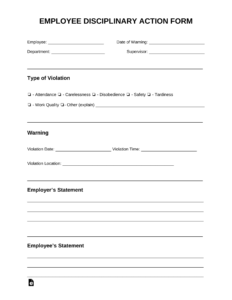Dealing with workplace complaints is never easy. It’s a delicate situation that requires sensitivity, fairness, and above all, thorough documentation. Whether it’s a minor misunderstanding or a serious allegation, having a solid system in place to record everything is crucial for protecting both your employees and your company. A well-structured HR complaint documentation template can be your best friend in navigating these tricky waters.
Think of it this way: imagine trying to piece together a puzzle without all the pieces. That’s what it’s like trying to resolve a complaint without proper documentation. You’re left guessing, relying on memory, and potentially missing important details that could impact the outcome. Using a HR complaint documentation template ensures you capture all the essential information in a consistent and organized manner. This not only helps you investigate the complaint effectively but also provides a clear record of the process should any legal issues arise.
This article will walk you through why a good HR complaint documentation template is essential, what key elements to include, and how to use it effectively. We’ll break down the process, making it less daunting and more manageable so you can focus on resolving complaints fairly and efficiently, and ensuring a positive and respectful work environment for everyone.
Why A Comprehensive HR Complaint Documentation Template is Essential
Let’s be honest, nobody *wants* to deal with complaints. But they’re a part of life, especially in the workplace. And when they arise, having a robust documentation system is paramount. It’s about more than just ticking boxes; it’s about building trust, ensuring fairness, and protecting your organization.
First and foremost, proper documentation provides a clear and accurate record of the complaint from start to finish. This includes everything from the initial report to the final resolution. This transparency is crucial for demonstrating that the complaint was handled fairly and objectively. It helps to prevent accusations of bias or negligence, which can be incredibly damaging to your company’s reputation and morale.
Secondly, good documentation helps you to conduct a thorough investigation. By capturing all relevant details, you can more easily identify patterns, inconsistencies, and potential witnesses. This allows you to gather all the necessary information to make an informed decision. A well-documented investigation also shows that you took the complaint seriously and made a genuine effort to address the issue.
Furthermore, having a solid paper trail is essential for legal protection. If the complaint escalates to legal action, your documentation will serve as evidence of your organization’s efforts to resolve the issue responsibly and in accordance with applicable laws. Without proper documentation, you could be at a significant disadvantage in defending your actions.
Finally, using a standardized HR complaint documentation template ensures consistency across all complaints. This means that every complaint is handled in the same way, regardless of the individuals involved or the nature of the issue. This consistency promotes fairness and prevents the perception of favoritism or discrimination. It also makes it easier to track and analyze complaint trends, which can help you identify underlying issues and implement preventative measures to improve your workplace culture.
Key Elements of an Effective HR Complaint Documentation Template
Okay, so you’re convinced you need a better system. But what exactly should your HR complaint documentation template include? Think of it as building a house; you need a solid foundation and key structural elements to make it strong and reliable. Here’s a breakdown of the essential components:
Firstly, you’ll need basic information. This includes the date the complaint was filed, the names and contact information of the complainant and the accused, and a brief summary of the complaint. Make sure this section is clear and concise, capturing the essence of the issue without getting bogged down in unnecessary details.
Next, include a detailed description of the complaint. This is where the complainant can provide a more thorough account of what happened, including dates, times, locations, and any witnesses. Encourage the complainant to be as specific as possible, providing as much relevant information as they can recall. Include space for them to sign and date the description, confirming its accuracy.
Following the initial complaint, document all investigation steps taken. This includes interviews with the complainant, the accused, and any witnesses. Record the date, time, and location of each interview, as well as a summary of the key points discussed. Include any documents or other evidence gathered during the investigation.
Document the findings and conclusions of the investigation. This should be a clear and concise summary of what was found, based on the evidence gathered. If the complaint was substantiated, outline the specific policy or rule that was violated. If the complaint was not substantiated, explain why.
Finally, record the corrective action taken. If the complaint was substantiated, document the disciplinary action taken against the accused, as well as any other steps taken to address the issue. This could include training, counseling, or policy changes. Be sure to document any follow-up actions taken to ensure the issue has been resolved and to prevent future occurrences. A well-designed HR complaint documentation template will guide you through this process.
Having a robust HR complaint documentation template isn’t just about following procedures; it’s about fostering a culture of respect and accountability. It’s about creating a workplace where employees feel safe, valued, and heard.
It’s a commitment to fairness and transparency that ultimately benefits everyone involved, building a stronger and more productive work environment. Investing in a comprehensive HR complaint documentation template and using it diligently is an investment in your company’s future.


